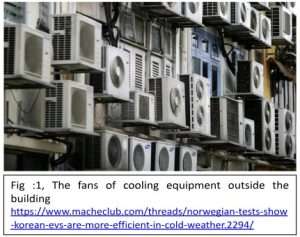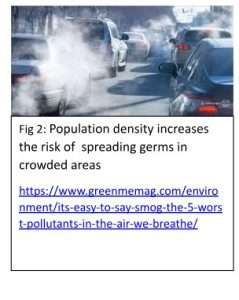Prof. Dr. Ban Taha Mohammed
College of Education for Pure Sciences
Essential issues in urban environments must be highlighted, and there is more than one reason [1]. Air conditioning inside the building is one of the primary factors that release heat to the environment outside the building due to the presence of fans of cooling equipment outside the building has aggravated the high temperature in the urban environment in cities [2] (Fig. 1).

This situation exists in narrow spaces, where it is common, medical offices in densely populated cities, public markets, and even restaurants and hotels in the city. This interaction leads to an increase in the temperature of cities and also aggravates the urban heat island effect [3], especially when the external parts of the air conditioner are designed at ground level or low altitudes, increasing the ambient temperature, especially in places between buildings, lacking air movement and high solar heat, creating a new environment that did not exist before the invention of air conditioning equipment. This situation contributes to the destruction of surrounding trees due to burns caused by the operation of this equipment [4]. The situation is worse in government buildings and utility facilities, where visitors are isolated from indoor air-conditioned buildings, leading to the risk of increased temperatures and accompanying humidity, creating a favorable environment for the growth of many types of microbes, including yeast, mold, and bacteria [5]. Common fungi that thrive in high temperature and humidity conditions are Aspergillus, Mucor, and Rhizopus in hot and humid environments, which can spread in densely populated areas, especially those with poor ventilation [6]. Stagnant and slow-moving air in cities leads to heat and humidity retention, and this stagnation can encourage bacterial growth, increasing the risk of infection, especially from specific yeasts that can infect the respiratory system and other parts of the body, affecting public health [7]. Population density increases the risk of spreading germs in crowded areas [8]. Responding to these crises requires strategies that implement sustainable development, improve urban design, and increase green spaces while implementing public health and safety measures to create an environment free of disease and pathogens [9-11] (Figs. 2,3).

There may be suitable solutions to reduce the extent of damage caused by all of the above. Building on successful experiences implemented by several countries that have led to significant improvements in environmental and public health, Singapore’s experience in confronting environmental challenges and climate change, the government made efforts to implement policies and guidelines on building designs and sustainable construction to develop an environmentally friendly city and conserve resources, and increase parks, green roofs, and public gardens, the experience of vertical gardens and green roofs helped manage heat, improve urban biodiversity, provide shade, and reduces temperatures. The surface improves air movement. And purify it from plankton and harmful microorganisms [12]. Recently, attention has focused on using sustainable construction, typically cool roofs, and installing reflective roofing materials to reduce heat gain in buildings, thereby reducing the need for air conditioning. Modern ventilation systems can also be used to improve air circulation and reduce humidity and the growth of mold and yeast, as is the case with the Cool Roofs program in the United States; this initiative has encouraged building owners to install reflective roofing materials to reduce heat gain and reduce energy costs [13]. Solar panels are a reliable means for sustainable development, reducing pollution and heat emissions and harnessing solar energy, an inexhaustible source [14]. Los Angeles is a city that has grown by implementing urban cooling strategies, including expanding tree canopy, implementing cool roofs, and increasing green space, as well as emphasizing sustainable water infrastructure and management to cope with flooding and heat and the use of rainwater and non-potable water to operate fountains and irrigate gardens [15]. These successful experiences can be used to develop urban and environmental realities in Iraqi cities by strengthening government, environmental, and health efforts to develop sustainable planning strategies applying the concept of sustainable development.
References:
[1] E. Heurkens, Private sector-led urban development projects: Management, partnerships and effects in the Netherlands and the UK, vol. 4. TU Delft, 2012.
[2] F. de Munck, How much can air conditioning increase air temperatures for a city like Paris et al., “How much can air conditioning increase air temperatures for a city like Paris, France?,” Int. J. Climatol., vol. 33, no. 1, pp. 210–227, 2013.
[3] T. C. Chakraborty, J. Wang, Y. Qian, W. Pringle, Z. Yang, and P. Xue, “Urban versus lake impacts on heat stress and its disparities in a shoreline city,” GeoHealth, vol. 7, no. 11, p. e2023GH000869, 2023.
[4] J. G. Calvert et al., “Local air pollution in fast developing countries (Technical Report),” Pure Appl. Chem., vol. 67, no. 8–9, pp. 1407–1410, 1995.
[5] A. M. Purcell et al., “Decreased growth of wild soil microbes after 15 years of transplant‐induced warming in a montane meadow,” Glob. Chang. Biol., vol. 28, no. 1, pp. 128–139, 2022.
[6] M. Jestin et al., “Poor outcome associated with mucormycosis in critically ill hematological patients: results of a multicenter study,” Ann. Intensive Care, vol. 11, pp. 1–8, 2021.
[7] A. Rodríguez, M. Tajuelo, D. Rodríguez, S. Seseña, P. Ruiz, and M. L. Palop, “Assessment of chemical and microbiological parameters of indoor swimming pool atmosphere using multiple comparisons,” Indoor Air, vol. 28, no. 5, pp. 676–688, 2018.
[8] R. E. L. Paul, M. Cote, E. Le Naour, and S. I. Bonnet, “Environmental factors influencing tick densities over seven years in a French suburban forest,” Parasit. Vectors, vol. 9, pp. 1–10, 2016.
[9] U. Sdg, “Sustainable development goals,” energy Prog. report. Track. SDG, vol. 7, pp. 805–814, 2019.
[10] M. J. N. O. Panao, H. J. P. Gonçalves, and P. M. C. Ferrão, “Numerical analysis of the street canyon thermal conductance to improve urban design and climate,” Build. Environ., vol. 44, no. 1, pp. 177–187, 2009.
[11] H. Roberts, R. McEachan, T. Margary, M. Conner, and I. Kellar, “Identifying effective behavior change techniques in built environment interventions to increase use of green space: a systematic review,” Environ. Behav., vol. 50, no. 1, pp. 28–55, 2018.
[12] B. C. L. Yin and R. Laing, “Myths of sustainability: an evaluation of their enduring influence on sustainable construction in Singapore.,” Archit. Civ. Eng., 2017.
[13] T. J. Taylor and C. Hartwig, “Cool roof use in commercial buildings in the United States: An energy cost analysis,” ASHRAE Trans., vol. 124, no. 3, pp. 88–96, 2018.
[14] A. Ahmad, O. Prakash, R. Kausher, G. Kumar, S. Pandey, and S. M. M. Hasnain, “Parabolic trough solar collectors: A sustainable and efficient energy source,” Mater. Sci. Energy Technol., vol. 7, pp. 99–106, 2024.
[15] L. S. Kalkstein, D. P. Eisenman, E. B. de Guzman, and D. J. Sailor, “Increasing trees and high-albedo surfaces decreases heat impacts and mortality in Los Angeles, CA,” Int. J. Biometeorol., vol. 66, no. 5, pp. 911–925, 2022.





























































